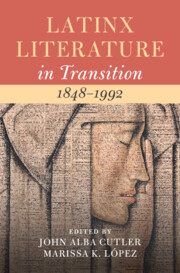Book contents
- Latinx Literature in Transition, 1848–1992
- Latinx literature in transition
- Latinx Literature in Transition, 1848–1992
- Copyright page
- Dedication
- Contents
- Figures
- Contributors
- Acknowledgments
- Introduction
- Part I Space
- Part II Being
- Part III Time
- Part IV Form
- Chapter 13 Entre Balas y Rugidos
- Chapter 14 Modernism’s Workshops
- Chapter 15 Lyrical Mobilities
- Chapter 16 Bullets, Guns, and Tattoos
- Part V Labor
- Bibliography
- Index
- References
Chapter 16 - Bullets, Guns, and Tattoos
Debility in the US Central American Literature of Salomón de la Selva and Héctor Tobar
from Part IV - Form
Published online by Cambridge University Press: 10 April 2025
- Latinx Literature in Transition, 1848–1992
- Latinx literature in transition
- Latinx Literature in Transition, 1848–1992
- Copyright page
- Dedication
- Contents
- Figures
- Contributors
- Acknowledgments
- Introduction
- Part I Space
- Part II Being
- Part III Time
- Part IV Form
- Chapter 13 Entre Balas y Rugidos
- Chapter 14 Modernism’s Workshops
- Chapter 15 Lyrical Mobilities
- Chapter 16 Bullets, Guns, and Tattoos
- Part V Labor
- Bibliography
- Index
- References
Summary
The article studies the war artifacts and military symbols, particularly bullets and tattoos, in Héctor Tobar’s novel about the Guatemalan civil war, The Tattooed Soldier (1998) and Salomón de la Selva’s testimonial poetry about World War I, El soldado desconocido (1922). Although the texts were written more than seven decades apart, the two authors’ treatments of these objects demonstrate ligatures between soldiering, disability, and the frailty of the Global North’s patriotism in Latinx narratives. They depict the effects of war on vulnerable bodies as well as the central value of the figure of the soldier. In his novel, Tobar builds on de la Selva’s poetic explorations, from the soldiers in the European trenches to the soldier turned immigrant. Their narratives capture how soldiers in global and local conflicts look for a sense of masculinity and patriotism, but instead expose the atomization and dark side of contemporary American cultures across borders. For both authors, war creates physical and psychological wounds that go unrecognized and for which the US is never held responsible. Tobar and de la Selva reveal war artifacts and militaristic symbols as original, tangible sites that expose this reality.
Keywords
- Type
- Chapter
- Information
- Latinx Literature in Transition, 1848–1992 , pp. 277 - 294Publisher: Cambridge University PressPrint publication year: 2025

